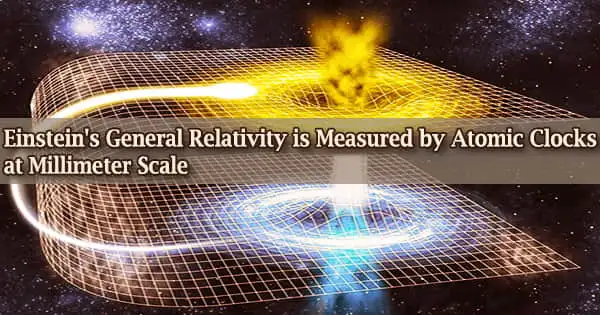A millimeter, or roughly the width of a sharp pencil tip, is all that separates two tiny atomic clocks, which are shown to tick at different rates by JILA physicists’ measurements of time dilation, a phenomenon related to Albert Einstein’s general theory of relativity, at the smallest scale ever.
The studies, which are detailed in the Feb. 17 issue of Nature, present a method for making atomic clocks 50 times more accurate than current best designs and provide a potential path to resolving the fundamental physics conundrum of how relativity and gravity interact with quantum mechanics.
The National Institute of Standards and Technology (NIST) and the University of Colorado Boulder jointly run JILA.
“The most important and exciting result is that we can potentially connect quantum physics with gravity, for example, probing complex physics when particles are distributed at different locations in the curved space-time,” NIST/JILA Fellow Jun Ye said. “For timekeeping, it also shows that there is no roadblock to making clocks 50 times more precise than today which is fantastic news.”
General relativity, proposed by Albert Einstein in 1915, is a theory that explains large-scale phenomena like the gravitational effect on time and has numerous practical uses, including the correction of GPS satellite data. The hypothesis has been around for more than a century, but physicists are still interested by it.
In order to measure relativity more precisely, NIST researchers have been using atomic clocks as sensors. This work may help to ultimately explain how relativity interacts with quantum mechanics, the theory that governs the universe of subatomic particles.
Atomic clocks in a gravitational field tick at different rates at various elevations, according to general relativity. When detected in stronger gravity, nearer to Earth, the frequency of the atoms’ emission is lowered and shifted toward the red end of the electromagnetic spectrum.
In other words, time moves more slowly at lower altitudes. The NIST researchers detected this effect in 2010 by comparing two independent atomic clocks, one of which was placed 33 centimeters (approximately 1 foot) above the other. This effect has been demonstrated numerous times.
In a laboratory setting resembling the group’s earlier atomic clocks, the JILA researchers have now observed frequency shifts between the top and bottom of a single sample of around 100,000 ultra-cold strontium atoms put into an optical lattice.
This a completely new ballgame, a new regime where quantum mechanics in curved space-time can be explored. If we could measure the redshift 10 times even better than this, we will be able to see the atoms’ whole matter waves across the curvature of space-time. Being able to measure the time difference on such a minute scale could enable us to discover, for example, that gravity disrupts quantum coherence, which could be at the bottom of why our macroscale world is classical.
Jun Ye
The lattice, which can be thought of as a stack of pancakes made by laser beams, is extraordinarily large, flat, and thin in this novel scenario. Additionally, less powerful light than usual is employed to construct the lattice. By homogenizing the sample and extending the atoms’ matter waves, whose shapes indicate the likelihood of finding the atoms in particular locations, this design eliminates the distortions in the lattice typically brought on by the scattering of light and atoms.
A record for quantum coherence was set by the atoms’ tightly controlled energy states, which allowed them to alternate between two energy levels in perfect unison for 37 seconds.
The Ye group’s imaging advancement, which produced a microscopic map of frequency distributions across the sample, and their way of comparing two sections of an atom cloud as opposed to the conventional methodology of using two different clocks were crucial to the new findings.
In line with expectations, the measured redshift over the atom cloud was extremely small, in the range of 0.0000000000000000001. The changes build up to have significant effects on the universe as well as technology like GPS, despite being much too small for humans to directly sense.
In around 30 minutes of data averaging, the study team found a solution to this disparity fast for this type of experiment. Their measurement precision was 50 times better than any other clock comparison after 90 hours of data.
“This a completely new ballgame, a new regime where quantum mechanics in curved space-time can be explored,” Ye said. “If we could measure the redshift 10 times even better than this, we will be able to see the atoms’ whole matter waves across the curvature of space-time. Being able to measure the time difference on such a minute scale could enable us to discover, for example, that gravity disrupts quantum coherence, which could be at the bottom of why our macroscale world is classical.”
There are numerous uses for better clocks besides timekeeping and navigation. Ye believes that atomic clocks can act as telescopes to view the farthest reaches of the cosmos as well as microscopes to discern minute connections between quantum mechanics and gravity.
He is utilizing clocks to search for the mysterious dark matter, which is thought to make up the majority of the universe’s mass. Through the use of a measurement discipline known as relativistic geodesy, atomic clocks are also positioned to enhance models and understanding of the shape of the Earth.
Funding was provided by the Defense Advanced Research Projects Agency, National Science Foundation, Department of Energy Quantum System Accelerator, NIST, and Air Force Office for Scientific Research.





